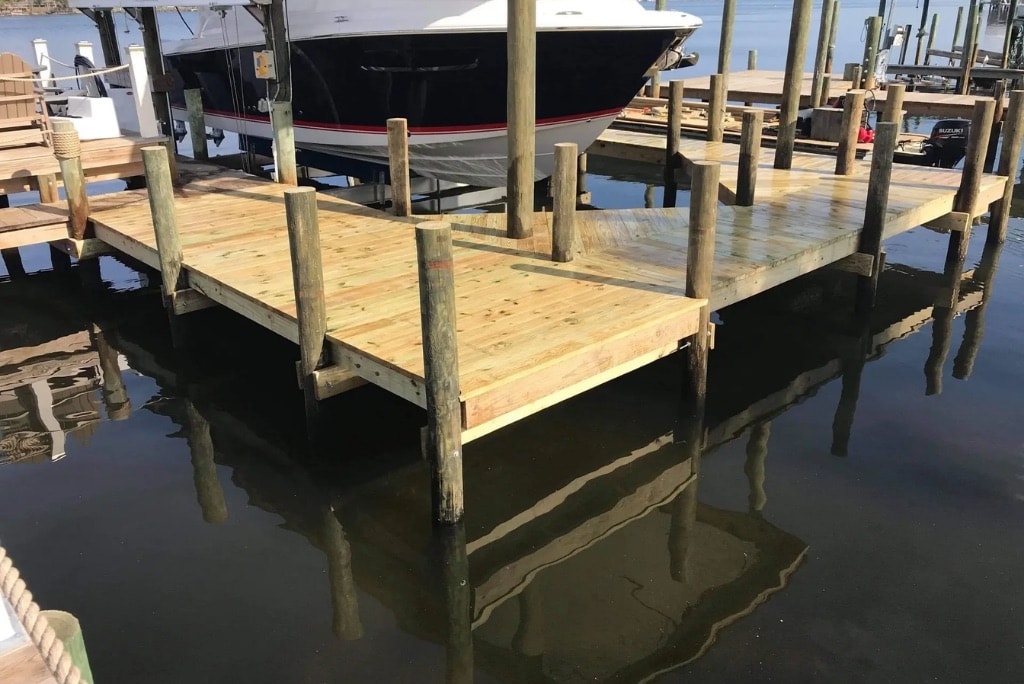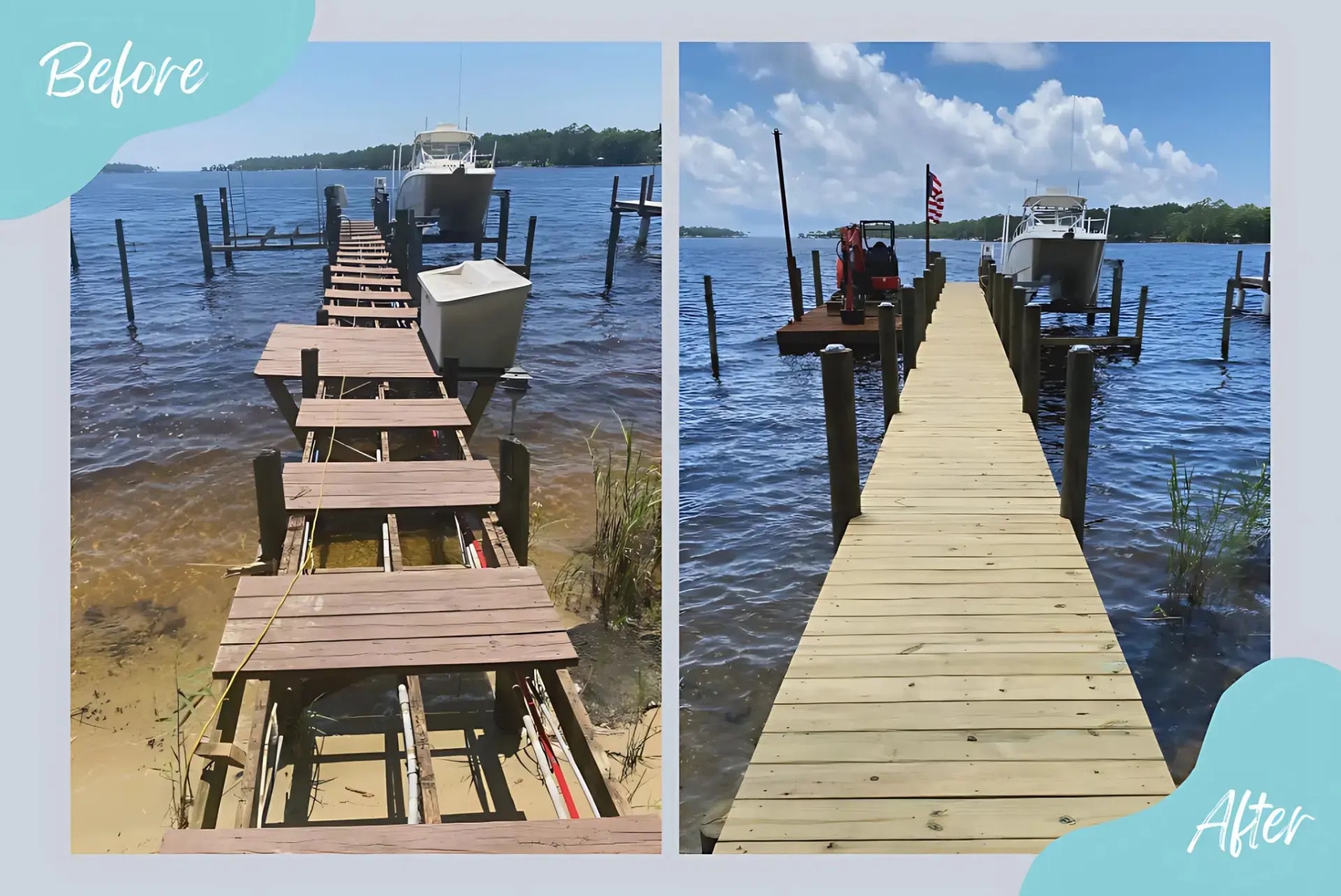
Building a dock on your waterfront land is an exciting project that enhances both its visual appeal and practical use. Whether you’re envisioning a serene spot for relaxation or a robust boat dock for mooring, careful planning and understanding the permits and regulations governing how docks are constructed is essential to ensure a successful outcome. From choosing the best design to understanding dock permits, this guide by Summit Marine Development covers all the essential steps to help you build your perfect dock.
At Summit Marine Development, we specialize in turning your dock dreams into reality. With years of expertise in dock construction, we manage everything from design and permitting to the final build, delivering a seamless process and a durable dock customized to your needs.
Step 1: Evaluate Your Waterfront Property and Water Conditions
Before starting your dock-building project, begin by evaluating your shoreline and the specific characteristics of your site’s water. Consider factors like water levels, the water line, and whether your property is near an ocean or still waters.
This evaluation helps determine the best type of dock—whether a fixed or floating dock—while ensuring compliance with regulatory requirements. Certain permits, particularly permit-by-rule, authorize the construction of these structures, ensuring adherence to flood hazard regulations and environmental protection measures.
Fixed docks are ideal for stable water levels and provide a strong foundation, often secured with concrete or support posts.
Floating docks are ideal for areas with changing water levels, as they adjust naturally with the tide.
Summit Marine Development Tip: Our team conducts a detailed site analysis, considering the unique aspects of your land and waterfront to recommend the ideal dock design for your location and needs.
Step 2: Choose the Right Dock Design
The design of your dock should align with your property layout, shoreline, water conditions, and intended use. Whether you’re envisioning a pier dock, a movable dock, or a combination of both, the design should balance functionality and aesthetics.
Key design considerations:
Decking material: Choose between pressure-treated wood, composite decking, or other durable options.
Composite decking: Made largely of plastic, this material is weather-resistant and low-maintenance, though it can heat up and may have a less appealing appearance compared to natural wood.
Incorporate features like mooring posts or platforms for leisure and storage.
Factor in bad weather by designing for strength and durability.
Summit Marine Development Tip: We customize every dock design to meet your goals, whether you need a private dock for leisure or a commercial-grade dock for multiple boats.
Step 3: Secure Dock Permits
Navigating permits is a critical step that ensures your dock complies with local, state, and environmental regulations. At Summit Marine Development, we handle this process for you, saving you time and hassle.
Steps to secure permits:
Research local regulations to determine what permits are required for dock installation.
Submit a detailed site plan, including placement and the dock’s impact on the water line.
Address any feedback or modifications required by local authorities.
Summit Marine Development Tip: Our experienced team is well-versed in the permitting process and works closely with local authorities to ensure your project is fully compliant.
Step 4: Select the Best Materials for Your Dock
Choosing the right material and structural components is key to building a durable and visually appealing dock that is properly supported.
Popular material options:
Pressure-treated wood: An affordable, natural choice perfect for stationary docks.
Composite decking: A weather-resistant, low-maintenance option for floating docks or pier docks.
Concrete: A strong material for heavy-duty stationary docks in high-traffic or harsh water conditions.
Summit Marine Development Tip: We guide you in selecting the best material by evaluating your budget, maintenance needs, and aesthetic preferences.
Step 5: Begin the Construction Process
With permits secured and plans finalized, it’s time to begin the dock-building process. Summit Marine Development’s skilled team guarantees a seamless construction, prioritizing quality and lasting durability every step of the way.
Key steps in construction:
Installing pilings for stationary docks or anchoring systems for movable docks.
Building the deck using the chosen decking material.
Adding custom features like mooring areas, railings, or ladders.
Ensuring that each component is installed at the right time and under the right conditions is crucial for a stable and sturdy dock.
Summit Marine Development Tip: We oversee the entire construction process from start to finish, prioritizing safety, efficiency, and clear communication every step of the way.
Building the Dock Frame
Building the dock frame is a crucial step in the construction process, as it provides the structural support for the entire dock. Ensuring that the frame is built to withstand the elements and heavy use is essential for a long-lasting dock.
Decking and Railings
Decking and railings are essential components of a dock, providing a safe and secure surface for users. The right design and installation techniques can significantly enhance the dock’s aesthetics and functionality.
Boat Dock Features and Designs
Boat dock features and designs can vary widely, depending on the intended use and functionality of the dock. Customizing your boat dock with the right features can significantly enhance its usability and overall design.
Step 6: Enjoy Your New Dock
Once your dock project is complete, it’s time to enjoy the benefits of your investment! Whether you’re docking a boat, entertaining guests, or fishing, your dock will become a centerpiece of your waterfront property.
Summit Marine Development Tip: We stand by the quality of our work and offer maintenance and repair services to ensure your dock stays in excellent condition for years to come.
Why Choose Summit Marine Development for Your Dock-Building Project?
At Summit Marine Development, we pride ourselves on building durable, high-quality docks that enhance the visual appeal and functionality of your waterfront property.
Here’s why clients trust us:
Expert Craftsmanship: Our skilled team uses the best construction techniques for long-lasting results.
Personalized Solutions: We design docks tailored to your specific needs, from floating docks to private docks with boat slips.
Full-Service Approach: From permitting to installation, we handle every aspect of your project.
Commitment to Quality: We use premium materials, like treated wood and composite decking, to ensure durability and low maintenance.

Start Your Dock-Building Project Today
Are you ready to transform your waterfront property with a custom-built dock? Summit Marine Development is here to guide you through every step of the dock building process, from planning and permitting to construction and completion.
Contact Summit Marine Development today for a free consultation, and let’s create the perfect boat dock for your property.
FAQs
1. How long does it take to build a dock?
The timeline varies depending on the dock’s size, design complexity, and permitting process. At Summit Marine Development, we provide a detailed timeline upfront to ensure transparency.
2. What’s the best material for dock decking?
The best decking material depends on your goals. Composite decking is low-maintenance and durable, while pressure-treated wood offers a timeless, natural look.
3. Do I need permits for my dock?
Yes, most areas require permits to ensure compliance with local regulations. Summit Marine Development handles this process for you to make it hassle-free.
4. Can a dock withstand bad weather?
Yes, with expert construction and durable designs. Our docks are built to endure tough water conditions, including storms and changing ocean water levels.
5. What’s the difference between a fixed dock and a floating dock?
A fixed dock is anchored with pilings and provides a permanent, stable platform. A floating dock rises and falls with the water, making it ideal for areas with changing water levels.
6. How do I maintain my dock?
Regular maintenance, such as cleaning and inspecting for damage, is essential. Summit Marine Development offers ongoing maintenance services to keep your dock in top shape.


